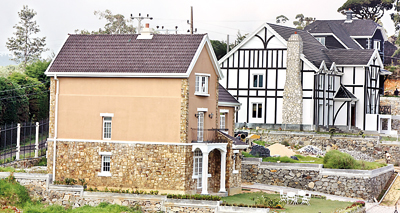You can truly savour ‘little England’
Imagine yourself in a quaint but luxurious English cottage in the countryside. You’re snuggled up on a comfy sofa. Outside, the night is cold and windy, but here you can warm your hands at the flames burning merrily in your Scottish fireplace. Though you cannot see it, you appreciate the dual layered walls of your house – they keep the noise out and the warmth in. When you place your feet on the carpeted floor, you don’t bother with slippers. The floors are warm – radiant floor heating technology has been installed so that an intricate system of specialised pipes carrying boiling water runs underneath your feet. The heat they give off passes through your floors and into the room itself; quietly, gently warming the entire building. Now, imagine you’re in Nuwara Eliya.

The hill station retreat is where you’ll find Vasantha Jayasuriya’s Little England Cottages. “The concept of the project came from Nuwara Eliya’s colonial past,” says Vasantha, who is the CEO of Jaysons Group of Companies. ‘Little England’ was once the playground of British civil servants and planters in Ceylon and the town still retains a certain colonial air. Vasantha and his son Vivek Jayasuriya have been working closely on the project and share a love of English architecture. So far, they’ve built five cottages on the eight-acre site and have plans for 36. The land overlooks the majestic Pedro Mountain range – the highest in Sri Lanka – and is surrounded by green tea fields and forest owned by the Forestry Institute.
The appeal is in the detail. The gated community has high walls – an intimidating 10 ft tall fence surrounds the area and manned security gates but within, neighbours enjoy only hedges, landscaped gardens and open spaces. ‘Nature strips’ and Australian standard curbs and pavement design will make walking around pleasant and residents can get their exercise on roughly 1,100m of jogging track. However, it is the houses themselves that are the real showpieces.
Each is designed to mimic the architectural traditions of a certain era – Victorian, Georgian, Edwardian or Tudor, you can take your pick.
Unlike the longer eaves in Sri Lankan design, these cottages boast short eave-slated roofing, but the dual walls provide additional barriers against heavy winds and rain. Double glazed windows also serve to keep the heat in. The houses, which include utilitarian kitchens, pantries, two bedrooms, a loft suite and quarters for a caretaker and a chauffeur, come fully furnished in heavy teak furniture – they are meant to be sold to corporate clients and individual families, who may then choose to rent them out as holiday homes. After a slow start in 2009, the project appears to be finally gaining momentum. They hope to finish another five houses in the next four months, says Vasantha, with bigger projects like the community clubhouse scheduled for completion by 2014.
They expect buyers to thrill to the idea of radiant floor heating. “This is being done for the first time in Sri Lanka,” says Vasantha who has relied heavily on the expertise of his U.S based plumbing consultant, Jagath Wijeratne. Together the two men brought down all the raw materials from abroad and oversaw the installation. Vivek explains that Jagath’s design ensures the heating of the house is consistent and even. This is possible because the pipes are laid close together under the floor. With insulation below them, the heat has nowhere to go but up, moving through the floor and rising until it fills the whole room. For Jagath the pros and cons are obvious: the technology has to be implemented by a knowledgeable, experienced hand and it’s comparatively more expensive with less margin for error. Digging out the tubes to fix a mistake simply isn’t an option which was why they wanted to get it right the first time, says Jagath.
The house is also cleverly divided into five ‘zones’ that allow you to customise the temperature in different rooms to suit the preferences of its inhabitants – grandma might want a warmer room than her teenage grandson. Though originally imagined into existence by the Germans, the technology has been perfected by the Americans, contends Jagath who has been in the business for some 20 years.
Vivek and his father have been pleased by the enthusiasm with which their project has been greeted. They might have even kicked off a mini-trend in India. Vasantha has an email from a very impressed Brotin Banerjee, Managing Director and Chief Executive Officer of Tata’s Housing Development Company in which he says he would like send over a team of architects and surveyors to study the project. In the meantime, the houses are already being snapped up. As the interview winds up, Vasantha stops to give credit to where he feels it is most due. He owes all his success, says the devout Christian, to the blessings of God.
Follow @timesonlinelk
comments powered by Disqus


















